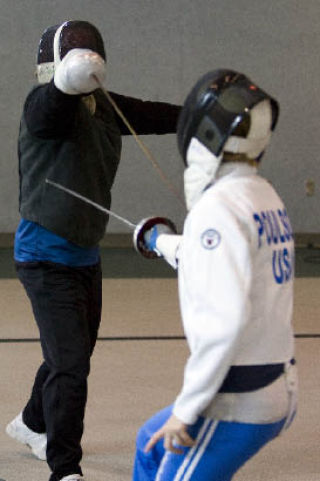Their tips inches apart, the two swords quiver like a jolt of electricity just ran through them. The first contact is a tease, a taunting touch of metal on metal. Tin, tin, tin. Suddenly, a blade lunges, forcing each contender into the heart of the fight, the sporadic clink of the swords increasing rapidly until one fencer plunges off the battle field.
No, this isn’t a scene from Pirates of the Caribbean. This is my Saturday afternoon.
I’ve jumped into the middle of a six-week series of Saturday classes put on by the Washington Fencing Academy at the Issaquah Community Center. Instructor and academy co-founder Kevin Mar leads 10 other brave souls as they learn the art of sword-fighting and stave off sweat, all while bobbing around in a fencing mask.
When I ask Marj Oliver, a Burien resident, what the past two sessions have been like, she immediately replies, “Suffering! But you notice we’re still coming back, so there’s got to be something to it.”
I laugh, but am slightly unnerved.
Children as young as 7 years old line up with adults, their fellow students, as they play warm-up games. Mar sends me to the side to work with Skyline High School sophomore Jordan Rixon, a 16-year-old who went to nationals this past July. The class has already learned several steps and foreign actions I can’t spell, so I pay attention.
She patiently shows me what the “en garde” position looks like. She perches delicately on her left toe and right heel, her feet making a perfect right-angle on the ash-gray carpet. If she were a bird, she’d be a poised sparrow, ready to spring off a branch at a moment’s notice and leap at an opponent. If I were a bird, I’d be a penguin — wobbly and challenged in the flying department.
After going over basic footwork terms several times — advance, double advance, lunge, scissor, recover — I’m deemed ready to join the group. Being left-handed, Mar places me on the left side of the group, where I will do the least damage. We play footwork games, like one called “Class Says,” a variation of “Simon Says.” I last slightly longer than the 7-year-old.
Although my fencing experience is confined to the past hour of my life, I can already tell it’s a lot more difficult than I thought it would be. Fencing takes a certain agility, the ability to balance and be light on one’s feet. In order to get the proper en garde position down, Rixon originally told me to put my feet in a V, heels touching — first position in ballet. Fencing is a dance.
And every dance must have proper costumes. We don white jackets that zip in the back, with a loop on the bottom for our right legs. They remind me of upside-down overalls. I shove my head into a mask that smells faintly of my friend’s golden retriever and grab a sword, or epee, from the equipment bag.
This is the hardest part. Now, not only do my feet demand my concentration, but my arms do as well. Mar teaches us basic parrying techniques, which is when you block your opponent’s blade, and how to riposte, or become aggressive after defending yourself. My favorite maneuver is the counterattack, where you jump back from an opponent’s lunge and tap them on their extended hand with your epee, your arm in a graceful arch. It seems strange to aim for a hand, but Mar says “The main targets are the hand and the foot, because they’re closest.”
After several more drills, we play a few closing games. The last one is called “Last Man Standing,” where everyone duels within the same area, and the last person who hasn’t been touched, wins. A few seconds into it (when I’m eliminated), I head over to the break area and start unzipping. I watch as the last few competitors battle it out, their epees aggressive, yet delicate. It’s obvious why Mar says this is a lifetime sport; not only does it demand athletic strength, it also requires chess-like strategy.
I leave my first fencing experience relatively unscathed; I’m nursing a sore bicep and a bruise the size of an epee point on my shin from a well-placed counterattack. But physical pain doesn’t even register with me at the moment — I’m too busy beaming at the new skills I just acquired, if only at the most basic level. Ten-year-old Emma Tim, of Bellevue, shares my mindset.
“I think it’s really fun,” she says. “It’s a lot of work, but it’s worth it.”
Brittney Wong is an MIHS graduate. She can be reached at bwong@reporternewspapers.com or 425-391-0363, ext. 4052.


